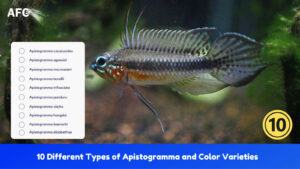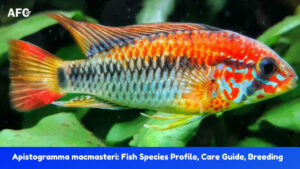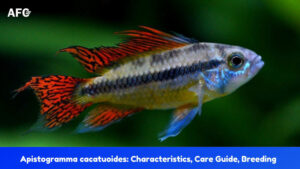The Silver Dollar Fish, also known as Metynnis argenteus, derives its name from its appearance. It is a large, flat fish, silver in color, which is native to the rivers of South America. It belongs to the same family as the Piranha and the Pacus, the Characidae family.
Although the silver dollar fish’s relatives (such as the Piranha) are famous for been aggressive carnivores, the silver dollar fish itself feeds on a primarily herbivorous diet, although due to its occasional eating of meat, it is technically classified as an omnivore.
In the wild, silver dollar fish are generally herbivores, but they will feed on meat if an easy meal is to be had. It generally inhabits small tributaries heavily overgrown with vegetation. It can then feed quite easily on the plentiful vegetable matter.
In fact, they’re one of popular freshwater fish in community aquariums. They are easy to care for so long as you’re aware of some specific requirements.

Species Summary
The scientific name for this fish is derived wholly from its appearance. Metynnis, meaning ‘with plowshare’ which refers to the laterally flattened body, and, argenteus, means ‘covered with silver,’ and Metynnis, means ‘with plowshare,’ a term which refers to the flattened body of the fish.
They are generally sold online and at pet shops for reasonable prices in bulk, since they need to be kept in groups (the minimum number of silver dollar fish in a tank is five). These fish are naturally skittish and nervous and they are used to travelling in schools, so the more silver dollar fish in a school, the better.
Silver dollar fish are easily startled; when startled, they may jump out of the aquarium, so a lid is necessary for your silver dollar tank.
Appearance & Habitat
The term “silver dollar fish” can refer to a number of different species within the Metynnis genus. Of particular note are the following two kinds of silver dollar fish: the spotted silver dollar fish and the red hood silver dollar fish.
Spotted Silver Dollar Fish
The spotted silver dollar fish has a body with silver as the background color but is distinguishable by the black spots found on its body, as its name suggests. This species of fish is native to French Guyana as well as Brazil. The spotted silver dollar fish can grow to a maximum length of 6.5 inches.
Red Hook Silver Dollar Fish
The red hook silver dollar fish, also known as Myleus rubripinnis, has an anal fin which is distinctive for its black trim and its red coloration. This kind of coloration for a silver dollar fish is unique and fairly obvious, making this type of fish easily identifiable.
It originates in the rainforests of South America. The red hook silver dollar fish can reach a length of up to nine inches in an aquarium environment and of up to twenty-two inches in the wild.
Silver Dollar Fish Tank Setup
Silver dollar fish are of the tropical freshwater variety, so the aquarium which houses them ought to mimic the natural habitat of the fish as closely as possible. These are pelagic fish, which means that most of the silver dollars’ swimming will take place toward the middle section and the top section of the water column, so they will require open free swimming areas.
What Size Aquarium Do They Need?
Silver dollar fish require a fairly large tank size: the tank needs to be able to hold at least 75 gallons of water for a school of five fish (which is the minimum number of silver dollar fish which ought to be kept together).
A 100 gallon tank is even more highly recommended, since these fish are so active and large, despite their peacefulness. For every fish you plan to add to the school, another ten gallons of water must be added. If you have the space and the wherewithal, the more silver dollar fish, the better; this will cause them to feel more secure.
Maintaining a tank of this size is quite a commitment, but for those with a moderate level of experience, a tank with silver dollar fish can make a lovely community aquarium.
Filter
Clean water is important for maintaining the health of your silver dollar fish, so a moderate flow rate and proper filtration are essential.
For this type of fish, use a large canister filter. The filter should be big enough to contain a large population of filtering microorganisms. It should also be able to pump a large enough volume of water to process the dissolved wastes in the tank.
Filters have a gallons per hour (GPH) rating that determines the size of tank for which they are suitable and how much water they can pump in one hour. A good rule of thumb for choosing a filter is that it should have a GPH four times the volume of the aquarium.
A 75 gallon tank, therefore, should have a filter with a GPH of 300. A 100 gallon tank would need a filter with a GPH of 400. Also, place a few power heads in the tank to assist with oxygenation and the movement of water.
A power head is a supplementary water pump placed inside the tank which contributes to the flow of water. However, do not use glass power heads, since these can be shattered easily by a fish as active as the silver dollar.
Heater
Choose a heater which will be able to maintain the tank water temperature at the optimal level for your silver dollar fish (between 75 and 82°F). Be sure that the heater can keep the water temperature stable, since sudden changes in temperature will be bad for the health of the fish and the overall aquarium.
Just as you should not use any glass power heads in your silver dollar tank, you also should not use glass heaters, as these can also be shattered by the fish, which are very active.
Plants And Decorations
Since silver dollar fish have a primarily herbivorous diet, the plants placed in the aquarium should not be too tasty. Hornwort and java fern are good choices.
Silver dollar fish will attempt to uproot and eat most other types of plants, so a lush and gorgeous emerald green aquascape with a lot of live aquatic plants will not suit this type of fish. If you desire this kind of lush aquarium design, you may want to consider another type of fish.
However, silver dollar fish are rather nervous and fairly skittish, so it is good to provide them cover and shelter in the form of tall artificial plants. These can be placed in the back of the tank. The rest of the tank should be left fairly open to provide plenty of swimming areas for the fish, which are quite active and require a lot of space to swim freely.
Light
Silver dollar fish require a low, more subdued amount of light, preferring their surroundings to be somewhat dim. Using a substrate that is darker in color can help with meeting their lighting needs, as it will reduce the amount of light that is reflected throughout the tank.
Water Parameters
The water temperature in the tank for your silver dollar fish ought to be maintained between 75 and 82°F with a pH between 5.5 and 7.5 and a KH of at least 3. The hardness of the water is somewhat flexible, ranging from 4 to 18 dGH.
How to Care for the Silver Dollar Fish
Silver dollar fish are fairly hardy, healthy, and resistant to a wide variety of diseases. If they are properly cared for, silver dollar fish can live for approximately ten years.
The fact that they are hardy and resistant to most diseases does not mean that you will never encounter any diseases with your silver dollar fish. Plants, decorations, substrate, and even other fish can carry bacteria.
Be sure to maintain the cleanliness of your tank with proper filtration and quarantine any problems so as not to upset the health balance of the tank. If a silver dollar fish gets sick, usually the disease will be limited to just one or a few of the fish in the tank, and this can be dealt with easily at an early stage. The best way to prevent disease in your silver dollar fish is to provide a proper diet and a healthy environment.
Diseases you may encounter with the silver dollar fish include skin flukes, ichthyobodo infection, parasitic infestations (worms, protozoa, etc.), general bacterial infections, and bacterial diseases.
Silver dollar fish are fairly peaceful fish and are very active swimmers that require a large amount of open space for free swimming. They will generally not bother other fish, although if placed with fish that are tiny, they will most likely be tempted to eat them by swallowing them whole.
Despite being generally peaceful most of the time, silver dollar fish can become somewhat aggressive during feeding times and may chase the other fish around the aquarium.
Foods and Feeding
Silver dollar fish are omnivores but prefer to be mainly herbivorous in diet. The silver dollar feeds on primarily vegetable foodstuffs, such as lettuces, plants, chickweed, cress, larger vegetable flakes, spinach, carrots, peas, cucumbers, boiled potatoes, pellets, tablets, and fruits.
It can also benefit from spirulina formula. It occasionally enjoys brine shrimp and bloodworms or other tiny fish. Ideally, this fish feeds numerous times each day. Provide to the fish only what they are able to consume in three minutes or fewer per feeding.
Silver Dollar Fish Tank Mates
Silver dollar fish require tank mates and should definitely not be raised on their own. A group of five silver dollar fish, at minimum, is highly recommended. The more fish, the better. They will feel more secure in a larger group.
Generally speaking, silver dollar fish are fairly peaceful and will not bother other fish. But do not keep them with any fish (that are extremely tiny (less than one inch in length), as they may eat such smaller fish, swallowing them whole.
If you want to keep other fish with your silver dollar fish in a community aquarium, choose tank mates which are peaceful enough not to bother other fish and large enough not to be eaten.
Some recommended tank mates for silver dollar fish include the green severum, blue acara, angelfish, yoyo loaches, nerite snails, and plecos. Be aware that the first three (green severum, blue acara, and angelfish) are cichlids, which are generally peaceful and normally make excellent tank mates for silver dollar fish, but they become exceedingly aggressive and dangerous to other fish when spawning.
To prevent this, you can keep the water at a cooler temperature, which will discourage the cichlids from spawning.
Breeding
Silver Dollar Fish can be bred in captivity fairly easily, but an extremely large breeding tank is required. They may breed on their own in your tank if the environment is comfortable and large.
Spawning in the wild for silver dollar fish occurs in heavily vegetated, shallow areas of flooded tributaries and rivers. For the greatest chance of success in obtaining breeding pairs, begin with six or more juvenile fish and allow them to grow to sexual maturity (approximately 1 year of age and around 4 inches long, though size can vary).
For optimal results, condition females and males in separate tanks before breeding them. For 7 to 10 days, give them a diet of high quality vegetables and plants. Then choose a small group or breeding pair to transfer into the tank for breeding. When ready for breeding, males darken in color, specifically around the caudal, dorsal, and anal fins, and reddish areas intensify in color.
Prepare a separate breeding tank with warm (79 to 82°F), soft (4-8° dGH), slightly acidic (pH 6.0 to 7.0) water that is shallower in depth. Successful spawning has been achieved at temperatures as high as 90°F. It should hold a minimum of 40 gallons for a breeding pair and even more for a breeding group.
For filtration, use a small sponge filter (air-powered) to maintain a gentle water flow rate so as not to disturb the breeding process.
The breeding tank should be kept somewhat dim and should contain clusters of java moss or spawning mops on which the eggs can fall. Floating plants should be placed on the surface between which the breeders may spawn.
Males court females by chasing the females around the breeding tank and maneuvering right next to them. A female who is ready for breeding will release eggs near or within the floating plants, eggs which are then fertilized by the male. The non-adhesive eggs then fall to the tank bottom. Each female may generate up to two thousand eggs, which look slightly yellowish and transparent.
The fry can be raised more easily if you remove the parents from the tank. The eggs take three days to hatch, and the fry can swim on their own between 6 and 9 days later.
At first, feed them with infusoria-type foods. Later, they will be able to eat small plankton, powdered foods, brine shrimp nauplii, and vegetable flakes. Well-fed fry will grow fast and reach adult sizes in about six to eight months.
Conclusion
In summary, the silver dollar fish is an excellent fish for an aquarium keeper with a moderate level of experience.
In order to properly care for your silver dollar fish, make sure that you have a tank and an area large enough to accommodate at least five of these fish, as a smaller number will make them overly nervous and skittish. Be sure to provide plenty of open swimming areas.
If you have some experience with keeping an aquarium and are prepared for the commitment (in time, space, energy, and cost) that silver dollar fish require, then it is a beautiful investment which will enhance the aesthetics of the surrounding environment and allow you to care for peaceful, schooling fish with a fair amount of longevity and silvery beauty.
If you have a large enough tank and you have your heart set on silver dollar fish, then be sure to select plants, decorations, and artificial plants suitable for the kind of water conditions that your silver dollar fish will require. And if you want to have a community tank with different species of fish, be sure that those fish are large enough not to be eaten by the silver dollars and peaceful enough to coexist with them.





